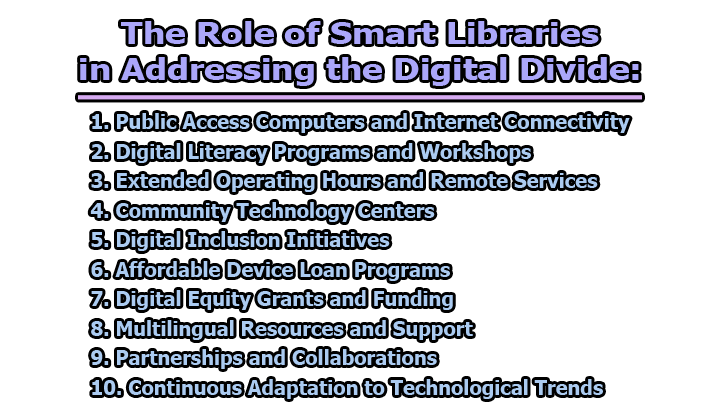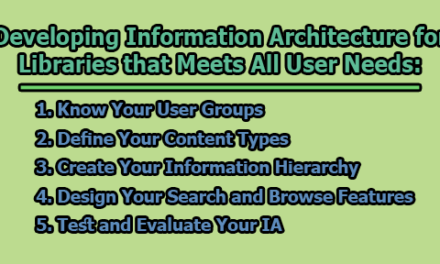The Role of Smart Libraries in Addressing the Digital Divide:
In an era where access to information and technology is crucial, the digital divide persists as a significant challenge, creating disparities among different population segments. Smart libraries have emerged as instrumental players in addressing this divide, pioneering initiatives and services to bridge gaps and ensure equitable access to digital resources and services for all community members. Through public access computers, internet connectivity, digital literacy programs, extended operating hours, community technology centers, digital inclusion initiatives, affordable device loan programs, digital equity grants, and multilingual resources and support, smart libraries are actively working to empower individuals facing barriers to technology access. In this article, we will explore the role of smart libraries in addressing the digital divide.
1. Public Access Computers and Internet Connectivity: Smart libraries recognize that providing free access to computers and the internet is a fundamental step in addressing the digital divide. Public access computers within libraries are equipped with essential software and applications, allowing patrons to engage in various online activities. Whether it’s conducting job searches, participating in online learning programs, or accessing crucial government services, these computers serve as vital tools for individuals who may not have such resources at home.
Moreover, smart libraries go beyond just offering public access computers; they also provide robust internet connectivity through Wi-Fi access points. This allows patrons to connect their personal devices, such as laptops, tablets, or smartphones, to the library’s network. The availability of Wi-Fi ensures that individuals can access online resources from anywhere within the library premises, promoting flexibility and convenience.
Libraries recognize the importance of accommodating diverse needs. Therefore, they often extend their operating hours to ensure that individuals have ample opportunities to use these resources. This commitment to providing free access to computers and internet connectivity empowers individuals to overcome barriers related to socioeconomic factors and geographic location, fostering a more inclusive digital environment.
2. Digital Literacy Programs and Workshops: In the digital age, literacy extends beyond traditional reading and writing skills to encompass digital literacy. Smart libraries play a pivotal role in addressing this aspect of literacy by offering diverse digital literacy programs and workshops. These initiatives cover a range of topics, catering to individuals with varying skill levels and interests.
Basic computer skills, internet safety, email etiquette, online privacy, and the usage of productivity software are common subjects covered in these programs. Through hands-on training, tutorials, and interactive workshops, libraries empower individuals to navigate the digital world with confidence and competence. These efforts are particularly crucial for those who may be unfamiliar with technology, providing them with the skills necessary for full participation in today’s society.
Additionally, smart libraries often establish partnerships with local organizations, businesses, and educational institutions to offer specialized training. This could include courses in coding, digital design, and technology entrepreneurship, providing patrons with opportunities to develop advanced digital skills that align with evolving industry demands.
3. Extended Operating Hours and Remote Services: Smart libraries acknowledge that traditional operating hours may not align with the diverse schedules of community members, including working professionals, students, and caregivers. In response, they extend their operating hours to offer services during early mornings, late evenings, and weekends. This commitment to extended operating hours ensures accessibility for a broader range of individuals, allowing them to utilize library resources at times convenient for them.
Furthermore, recognizing the prevalence of remote communication and services, smart libraries provide remote services such as virtual reference assistance and online chat support. These remote services enable patrons to seek help and access resources outside the physical library locations. Whether it’s a reference question or assistance with digital resources, individuals can conveniently engage with library services from the comfort of their homes or any location with internet access.
By extending operating hours and embracing remote services, smart libraries demonstrate their dedication to breaking down barriers associated with time constraints and geographical limitations, making digital resources more accessible to all.
4. Community Technology Centers: Smart libraries go beyond providing scattered computer access by establishing dedicated Community Technology Centers within their facilities. These centers serve as hubs for digital learning and skill development, providing a supportive environment for individuals to explore technology at their own pace.
Equipped with computers, internet access, and technology resources, these centers offer a focused space where patrons can engage in various digital activities. Trained staff is available to provide assistance and guidance, helping individuals navigate digital resources, complete online tasks, and develop essential digital literacy skills.
Community Technology Centers often host technology-focused programs and workshops that cover a spectrum of topics. These may include computer basics, internet safety, digital privacy, coding, and job search skills. By creating these dedicated spaces, smart libraries enhance the learning experience and provide a supportive atmosphere for patrons to build their digital skills.
5. Digital Inclusion Initiatives: Smart libraries take proactive measures to address systemic barriers to access through comprehensive digital inclusion initiatives. These initiatives involve targeted outreach efforts to marginalized populations, including low-income families, immigrants, seniors, and individuals with disabilities.
Libraries collaborate with community organizations, schools, and local government agencies to develop tailored programs and services that meet the unique needs of these communities. This could involve providing technology training, distributing free or discounted devices, offering assistance with internet connectivity, and facilitating access to digital resources and online services.
The goal of these digital inclusion initiatives is not just to provide access but to engage directly with the community and address specific barriers preventing individuals from benefiting fully from digital resources. Smart libraries strive to create a more inclusive and equitable digital environment for all residents by actively identifying and dismantling obstacles to access.
6. Affordable Device Loan Programs: Recognizing that access to personal devices can be a significant hurdle for some individuals, smart libraries implement affordable device loan programs. These initiatives allow patrons to borrow laptops, tablets, and other devices for extended periods, enabling them to participate in digital learning opportunities and access online resources.
Device loan programs are designed to be inclusive, often offering devices for checkout free of charge or at a nominal fee. The loan periods are flexible, accommodating individual needs and ensuring that patrons have ample time to utilize the borrowed devices. Smart libraries also provide technical support and assistance with device setup and troubleshooting, ensuring that patrons can make the most of their borrowed devices and access online resources seamlessly.
By offering affordable device loan programs, libraries address one of the fundamental challenges of the digital age – access to personal technology – and open up opportunities for individuals who may not otherwise have access to digital devices.
7. Digital Equity Grants and Funding: Smart libraries actively pursue grants and funding opportunities to support digital equity initiatives within their communities. Collaboration with local, state, and federal agencies, as well as corporate and philanthropic partners, allows libraries to secure funding for technology upgrades, digital literacy programs, and outreach efforts aimed at reducing barriers to access.
These grants play a crucial role in expanding the impact of smart libraries’ initiatives. Funding may be allocated for purchasing new computers, upgrading internet infrastructure, developing digital literacy curricula, and hiring additional staff to support digital inclusion efforts. By securing external funding, smart libraries can amplify their reach and make a more significant impact on reducing the digital divide in their communities.
8. Multilingual Resources and Support: To ensure inclusivity, smart libraries prioritize the diverse linguistic needs of their communities. They offer multilingual resources and support services, recognizing that individuals with limited English proficiency also need access to digital information and learning opportunities.
Digital literacy materials, online tutorials, and instructional videos are provided in multiple languages, ensuring that language barriers do not hinder individuals from acquiring digital skills. Additionally, smart libraries offer language interpretation services for patrons who may require assistance with digital resources or accessing library services. Trained interpreters are available in person or via telephone or video chat, ensuring that individuals from various cultural backgrounds feel valued and empowered to engage with technology.
By offering multilingual resources and support, smart libraries create an inclusive and welcoming environment where individuals of diverse linguistic backgrounds can participate fully in the digital age.
9. Partnerships and Collaborations: Smart libraries understand the value of collaboration in expanding their impact. They actively establish partnerships with local organizations, businesses, and educational institutions to broaden the range of services and resources available to the community.
These partnerships may include collaborations with tech companies for the provision of advanced digital learning resources, joint initiatives with educational institutions for specialized training programs, and alliances with local businesses to create opportunities for technology-driven entrepreneurship. By leveraging external expertise and resources, smart libraries enhance the quality and scope of their offerings, ensuring that the community benefits from a diverse array of digital opportunities.
10. Continuous Adaptation to Technological Trends: In the rapidly evolving landscape of technology, smart libraries understand the importance of continuous adaptation. They invest in staying current with technological trends to ensure that their communities have access to cutting-edge resources and are well-prepared for the challenges and opportunities presented by the digital age.
This commitment involves regular assessments of technology infrastructure, updating digital literacy programs to align with emerging trends, and incorporating new technologies into library services. By staying ahead of the curve, smart libraries not only address current digital disparities but also equip their communities to thrive in an ever-changing technological landscape.
In conclusion, smart libraries are at the forefront of addressing the digital divide through a multifaceted approach. By providing access to technology, offering digital literacy programs, engaging in community outreach, and fostering inclusivity, these libraries play a crucial role in empowering individuals to navigate the digital landscape confidently. As technology continues to advance, smart libraries remain dedicated to bridging the digital divide and promoting digital inclusion within their communities.

Library Lecturer at Nurul Amin Degree College










